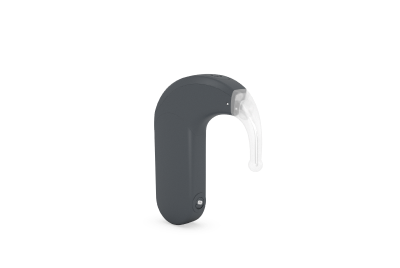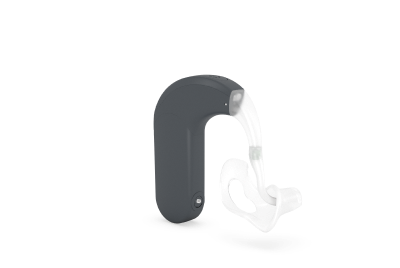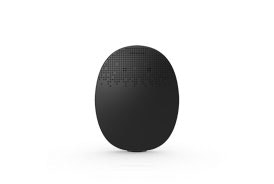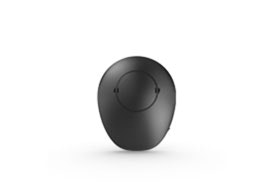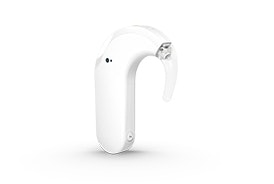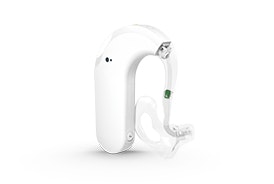Select your Language
Please, select a language for this page
Frequently Asked Questions
Find the answers to common questions about our hearing implants and devices.

General Questions
Find out more about hearing loss, as well as answers to common questions about hearing implants.
Hearing is the process by which our ears detect sound waves from the environment and convert them into nerve signals for the brain to understand as sound.
For a more detailed explanation, check out "How Hearing Works".
When a part of the ear doesn’t work as well as it should, it becomes harder to hear—this is known as hearing loss. Hearing loss can have many different causes, and can range in degree from mild to profound. There are many treatments for hearing loss, including hearing aids and hearing implants.
Learn more about the different types of hearing loss.
Hearing implant systems help restore hearing to individuals who don’t receive sufficient benefit from hearing aids.
A hearing implant system is the combination of an internal implant and an external audio processor. There are different types of hearing implants—such as a cochlear implant, middle ear implant, or bone conduction implant—designed for different types of hearing loss.
Learn more about the different types of hearing implant systems.
Although both hearing aids and hearing implants are designed to improve an individual’s hearing, a hearing implant is fundamentally different from a hearing aid.
A hearing aid only amplifies sound from outside your ear, which may not be effective if you have more severe hearing loss.
A hearing implant brings the sound directly to the inside of your ear, which enables more effective transmission of sound signals. Hearing implants can help individuals who can’t benefit from hearing aids.
If you have moderate-to-profound hearing loss, you may be a candidate for a hearing implant. A hearing specialist will be able to tell you more about your specific circumstances. If you’d like to learn more about the right hearing solution for you, just get in touch using our contact form and we’ll put you in touch with a hearing specialist in your area.
For children with severe-to-profound hearing loss, success is more likely if they are implanted at a young age. In a child’s first few years, the brain is especially ready to learn language and adapt to a hearing implant. In many cases, when children with profound hearing impairment are implanted early enough, their hearing and speech can develop in a manner similar to that of their peers without hearing loss.
Age of implantation is dependent on the minimum age indicated for the specific implant, the individual patient, and the advice of your doctor. If you have not consulted a hearing specialist yet, please fill out our simple contact form and we’ll help you get in touch with a hearing specialist in your area.
There is no upper age limit for receiving a hearing implant. Many of our recipients are older adults who have enjoyed a renewed quality of life after having their hearing restored.
Learning to use your restored sense of hearing is a process. Willingness to participate in rehabilitation programmes to develop listening skills is important for candidates at any age.
As with any surgery, there are some potential risks to cochlear implantation. The risks involved in cochlear implant surgery are low, however, and are comparable to those associated with other ear surgeries. The design of MED-EL hearing implants allows for minimally invasive surgical techniques. Patients should consult a medical professional for further information on possible risks.
A typical hearing implant surgery lasts from 1–3 hours. Patients are often back on their feet the next day. The length of the hospital stay is usually one or more days, depending on local practice.
Metal detectors or security screening devices will not affect the function of your implant. However, because the implant contains metal components, MED-EL will provide you with a recipient ID card to use at security checkpoints.
Yes, individuals with hearing implants can lead active lives with few restrictions. Your doctor or hearing professional is the best resource for individualized information.
We generally support and recommend the use of a helmet in situations where a helmet is normally used. It is important to protect the implanted area from a direct impact. Waterproof WaterWear covers should be used with the audio processor when taking part in water sports. Remove the audio processor before playing on plastic playground equipment that can generate high levels of static electricity.
MED-EL hearing implant systems are state-of-the-art, but new advances in sound processing and other technology are being developed all the time. With a simple fitting to update the external audio processor, you can upgrade to the latest technology without undergoing additional surgery.
These easy-to-upgrade systems allow MED-EL hearing implant users to take advantage of the latest innovations—both now and in the future.
If you’d like to learn more about receiving a MED-EL hearing implant system, fill out our simple contact form and we’ll put you in touch with a hearing specialist in your area. With a few routine assessments, your hearing specialist can find the right hearing solution for you.
Hearing Implant Systems
Want to know more about one of our hearing implant solutions? Pick an implant system for more information.
BONEBRIDGE is an active bone conduction system designed to restore hearing to individuals with conductive or mixed hearing loss, or single-sided deafness. BONEBRIDGE consists of an internal bone conduction implant and an external audio processor. It is suitable for adults and children aged five years and older.
Sounds from the environment are picked up by the microphones of the SAMBA 2 Audio Processor. These sounds are converted into electrical signals, which are transmitted to the BONEBRIDGE implant. The implant directly vibrates the bones of your head. These amplified sound vibrations travel to your inner ear where they are perceived as sound. The vibrations can be adjusted for different degrees of hearing loss.
No. The tiny mechanical vibrations of the bone conduction implant are so small that you won’t feel them.
BONEBRIDGE is designed for superior wearing comfort. Conventional bone conduction, or bone-anchored, hearing aids work in two ways. Some have an "abutment"—a small metal screw protruding through the skin, which the audio processor snaps on to. The skin around this screw is unable to ever heal completely, putting you at risk of skin infections and other complications. As BONEBRIDGE is implanted completely under the skin, this risk is not there.
Alternatively, a bone conduction hearing aid presses against the head using strong pressure, to allow the sound vibrations to travel through the skin to the bone. This constant high pressure can also cause skin problems, as well as headaches. With BONEBRIDGE’s unique design there is no pressure on the skin, making it much more comfortable to wear all day long.
If you’d like to find out if BONEBRIDGE is the right solution for you, you can experience bone conduction hearing prior to implant surgery. This is done with the aid of non-surgical bone conduction devices, which are positioned on the skin behind the ear. The sound quality of these devices may not be identical to that of BONEBRIDGE, but they will give you a good impression of what hearing with bone conduction is like.
Yes! Recipients of BONEBRIDGE may undergo MRI scans as long as certain safety conditions are met. In fact, it's covered by our one-of-a-kind MRI guarantee.
Please contact your MED-EL representative for additional information regarding the particular conditions of your MRI scan.
Recipients may undergo X-ray or CT scanning without restrictions.
The implant is typically activated 2–4 weeks after the surgical procedure. The audio processor can be fitted as soon as any minor swelling of the scalp, caused by the surgery, has subsided.
You can wear your audio processor as long as you wish. Most users wear it all day. However, it should be removed before you shower, bathe, or go to sleep.
You’ll simply place your SAMBA 2 Audio Processor over the implant site to begin using it for the day. Depending on usage, you will normally need to replace the battery approximately every 8–10 days.
If you’re interested in BONEBRIDGE, please contact a clinic near you. A team of hearing professionals will assess the type and degree of your hearing loss and determine if BONEBRIDGE is a suitable treatment option for you.
A cochlear implant system is a combination of an internal cochlear implant and an external audio processor. A cochlear implant system is designed to restore hearing to individuals with severe-to-profound sensorineural hearing loss.
Cochlear implants are suitable for anyone who has severe-to-profound sensorineural hearing loss. This includes young children right up to older adults.
Although both hearing aids and cochlear implants are designed to improve an individual’s hearing, the two types of devices are fundamentally different from each other.
A hearing aid only amplifies the sound reaching the middle ear, which may not be effective if the inner ear is damaged. A cochlear implant bypasses the inner ear and directly stimulates the auditory nerve. This means that cochlear implants can help people with a damaged inner ear, who receive no benefit from hearing aids.
Different implant and audio processors are available in different countries.
The implants available in your country may include the SYNCHRONY series (SYNCHRONY 2, SYNCHRONY 2 PIN, SYNCHRONY, and SYNCHRONY PIN), or other implants such as the
CONCERTO series, the SONATA series, PULSAR, C40+, and C40.
The audio processors available in your country may include SONNET 3, SONNET 2, SONNET, RONDO 3, RONDO 2, RONDO, and OPUS 2.
A cochlear implant turns sound waves into electrical nerve impulses, which the brain interprets as sound.
For a detailed explanation of how cochlear implants work, take a look at our Cochlear Implants page.
Many people only have one cochlear implant. However, there are proven benefits to having both ears implanted. These advantages include improved speech understanding in noise, better speech recognition, and improved sound localization. Many parents report that children with two implants are able to concentrate better in school and that they are less tired from social interaction.
Yes, it is possible to use a different brand of cochlear implant on each ear. Keep in mind that different systems may have different batteries, battery lifetimes, accessories, and other parts.
Yes, MED-EL's cochlear implant audio processors are designed to be compatible with all multi-channel MED-EL cochlear implants. This means you can easily switch to a spare audio processor for flexible wearing options, or upgrade to the latest processor without changing your implant.
MED-EL audio processors are designed with music enjoyment in mind. All our latest-generation MED-EL CI audio processors offer easy ways to stream sound from your smartphone, TV, and more. Please see our Connectivity page for more information.
To ensure you hear your best at all times, it's important to keep your audio processor clean and in good working order. Visit the Support pages for more detailed information about your audio processor.
SYNCHRONY PIN series, and CONCERTO PIN series are versions of the standard SYNCHRONY series and CONCERTO series implants, but with additional fixation pins. These small titanium pins are part of the implant housing and provide even more implant stability. Your surgeon will decide whether to use a PIN implant or not.
The electrode array is the long part of the implant that will be inserted into your cochlea. There are many different electrode arrays available, so your surgeon can choose the one that is most suitable for your cochlea. The full range includes: the FLEX Series, the FORM Series, and the Classic Series.
All MED-EL implants have an ultra-thin profile, making them barely noticeable behind your ear. The size of your audio processor depends on the type of processor, however each one is designed with comfort and style in mind. For the exact dimensions of your implant or processor, see the technical data on the individual product pages.
Yes! With the SYNCHRONY 2 and SYNCHRONY implants, you can undergo MRI scans of up to 3.0 Tesla without the magnet needing to be removed (unless diagnostically required), following certain conditions. This means there's no need for magnet removal surgery and no hearing downtime.
All MED-El implants since 1994 can also undergo standard MRIs of 1.5 Tesla. When having an MRI with any MED-EL cochlear implant, your medical professional should follow the conditions detailed in the instructions for use.
And because we’re dedicated to offering you outstanding MRI safety, all our cochlear implants since 1994 are covered against damage during an MRI scan by our MRI Guarantee.
The cochlear implant directly stimulates the part of the cochlea responsible for high-frequency sounds, while the acoustic component amplifies the natural volume of the low-frequency sounds. EAS takes advantage of a person’s residual natural hearing to provide optimal hearing outcomes.
VIBRANT SOUNDBRIDGE is a middle ear implant system designed to restore hearing to individuals with mild-to-severe hearing loss. VIBRANT SOUNDBRIDGE consists of an external audio processor and an internal middle ear implant. It is suitable for adults and children aged five years and older.
Sounds from the environment are picked up by the microphones of the SAMBA 2 Audio Processor. These sounds are converted into electrical signals, which are transmitted to the implant. The mechanical portions of the implant vibrate the structures of the middle ear. These vibrations can be amplified and adjusted for different degrees of hearing loss.
Hearing aids only increase the volume of sound reaching the eardrum and don’t vibrate the middle ear structures directly. VIBRANT SOUNDBRIDGE provides a clearer signal to the inner ear by directly vibrating the middle ear structures. Also, unlike a hearing aid, VIBRANT SOUNDBRIDGE doesn’t obstruct the ear canal.
VIBRANT SOUNDBRIDGE sends sound signals to the inner ear by mechanically vibrating the middle ear structures directly. VIBRANT SOUNDBRIDGE is designed for individuals with mild-to-severe sensorineural hearing loss, mixed, or conductive hearing loss.
In contrast, a cochlear implant sends sound signals to the cochlea in the inner ear by electrically stimulating the auditory nerve directly. A cochlear implant is intended for individuals with severe-to-profound sensorineural hearing loss.
Direct-drive technology sends sound signals directly to the middle ear with mechanical vibrations. VIBRANT SOUNDBRIDGE is a direct-drive device that uses a Floating Mass Transducer to precisely vibrate the structures of the middle ear. The design of VIBRANT SOUNDBRIDGE allows for implantation without surgical alteration of the middle ear.
The tiny Floating Mass Transducer, the part of the implant which is attached to the middle ear structure, is smaller than a grain of rice. The SAMBA 2 Audio Processor is approximately 3 cm in diameter and only 1 cm thick.
The procedure to implant VIBRANT SOUNDBRIDGE takes approximately 1–2 hours. Recipients are often back on their feet the next day. The hospital stay is usually one or more days, depending upon local practice.
As with any surgery, there are potential risks to implantation. However, the risks involved with the implant surgery are low and are comparable to other ear surgeries. Please consult your doctor for further information on possible risks.
Recipients of the latest generation of VIBRANT SOUNDBRIDGE (VORP 503) may undergo an MRI as long as certain safety conditions are met. In fact, the VORP 503 implant is covered by our one-of-a-kind MRI guarantee.
Please contact your MED-EL representative for additional information regarding the particular conditions of your MRI scan.
Recipients may undergo X-ray or CT scans without restrictions.
Yes, a hearing aid can be worn temporarily after the implant surgery. Once minor swelling from surgery has subsided, a hearing aid can be used until the audio processor is activated approximately 6–8 weeks after surgery. After your audio processor is activated, you’ll no longer need a hearing aid in the implanted ear.
Audio Processors
Have a question about one of our audio processors? Just pick a device to find out more.
Accessories
Have a question about one of our accessories? Just pick a device to find out more.
